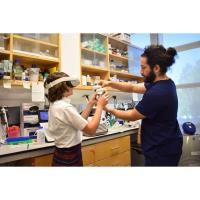Local middle-schoolers expand classroom experience with MCI visit
MOBILE, Alabama (5/5/2023) -- Middle-schoolers at Little Flower Catholic School visited the USA Health Mitchell Cancer Institute research wing last week to bring life to their learning experiences and potentially impact their future career choices.
Marie Migaud, Ph.D., a professor of pharmacology at the Frederick P. Whiddon College of Medicine and a researcher at MCI, said the group of 22 students in grades six through eight were mesmerized by their tour.
“We want to inspire middle schoolers before they have made up their mind about science, medicine and research, share what it is and why USA is a great place for it,” Migaud said. “It was a success all around!”
Last year, Migaud spoke to the Little Flower middle schoolers about careers in science and medicine, and when the science teacher, Jacob Smith, mentioned earlier this year how the students were fascinated by studying organs, cells and tissues, she mentioned it to a colleague.
“Considering that many of my colleagues at MCI have been quite active in showcasing the research at USA to high school students, it did not take much convincing to have them help me host something similar for the Little Flower students,” Migaud said.
The visit included a tour of the MCI research wing, where multiple researchers showcased tools used in their work:
- Kevin Lee, Ph.D., assistant professor of research in gynecologic oncology, showed them how cells could be grown and their number counted using microscopes;
- Tanvi Joshi, M.D., a gynecologic oncology fellow, shared her journey as a clinician and researcher;
- Elba Herrera, M.D., Ph.D., professor of pathology, presented how scientists use dyes to differentiate between healthy cells and cancer cells;
- Joel Andrews, Ph.D., manager of the MCI Cellular and Biomolecular Imaging Facility, demonstrated the power of electron microscopy to observe different organelles in cells;
- Jennifer Clark, Ph.D., pharmacology instructor, and Luxene Belfleur, Ph.D., research associate at the Mass Spectrometer Core Facility, displayed how analytical instruments like mass spectrometry can measure chemical components in biological samples;
- Ash Prakash, Ph.D., associate professor of biochemistry and molecular biology, discussed how molecules can make beautiful crystals and be visualized in 3D using virtual reality;
- Migaud used the screening robot to explain how different sciences, technologies and engineering come together to make research possible; and
- Susan Crutchfield, R.N., manager of community and physician outreach, talked to the group about cancer prevention and how to be mindful of the risks of smoking and more.
“All of the students were taken aback with the technology, employees, career opportunities and lessons in science presented to them,” Smith said. “The students have never been exposed to things like cell sorting analysis, advanced microscopy, liquid nitrogen, molecular structures or gas chromatography.
“They were also intrigued to discover the connection between cancer research and patient care. Most of them did not know that cancer researchers were working at the institute,” he said. “They were under the impression that it was a facility designed solely for patient care.”
Most of the students said the lab’s virtual reality tools were their favorite part of the tour, and the group was full of questions. But one stood out to Migaud.
“As we were entering the building where our research posters are lined up, a student asked a very cool question, ‘How do you get the data that generates the graphs on the posters?’” she said. “My answer: that’s research!”
Migaud said she and other MCI researchers are excited about the possibility of offering the tours to more middle school groups of about the same size in the region.
“This is a great age group as these students are still fascinated by science and have questions about things to do that they would not have even remotely considered had they not come to visit,” she said. “The feedback from the teachers who participated has been that these students, all 22 of them, are over the moon from the experience and are now bombarding them with questions.”
Smith said the impact of the tour extends beyond the time they spent at MCI into their classrooms and beyond.
“Their classroom experience was enhanced because of the connections they can now make with classroom discussions and practical uses in the real world,” he said. “When things like liquid nitrogen or molecules are discussed in class, they not only can visualize what these things look like, but also their practical uses. In addition to this, they can also relate to careers and professions that require the use of these things.”
###



